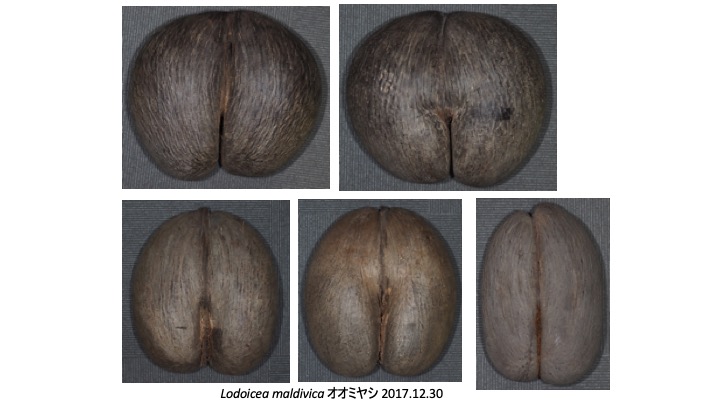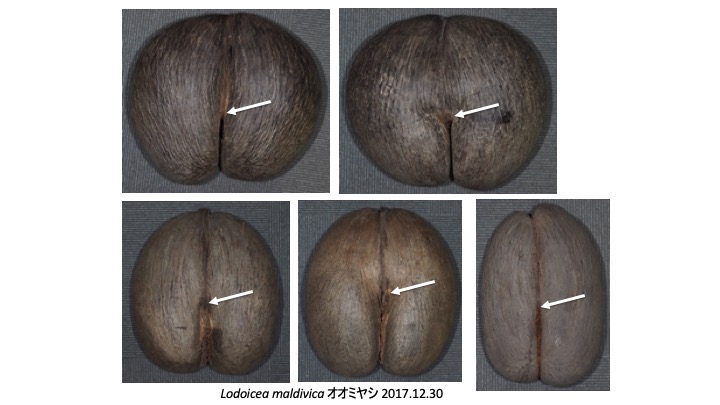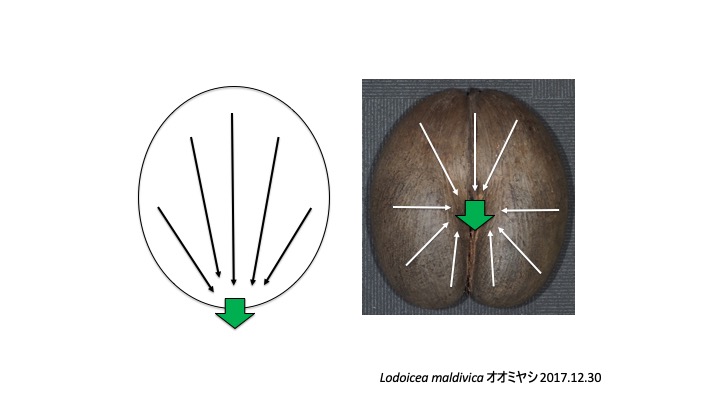
オオミヤシはフタゴヤシとも呼ばれる。これは、種子に割れ目が入って2つの種子があわさったように見えるからだろう。しかし、1つの種は1つの胚を持つだけで、双子ではない。どうしてこのような形をしているのだろうか。
Lodoicea maldivica is called double coconut because of the twin shape, although it is a single seed with a single embryo.

矢尻で示した場所に胚があり、ここから発芽する。
An embryo localizes at the arrow head.

オオミヤシが、他の椰子の実と異なった形をしている理由を研究した論文は見つからなかったが、もしかすると、種子の中心近くから発芽することで、胚乳から栄養を均等に効率良く得ることができるからなのかもしれない。種子の端に胚があると、胚からの方向によって、胚から胚乳の端までの距離が異なる。すると、胚乳の場所によって胚への栄養の供給効率が異なってしまう。一方、オオミヤシのように胚が種子の中心にあると、胚乳の端までの距離が均等になるので、どの方向からも均等に栄養が供給されるのかもしれない。発芽後、内乳がどのように減少していくのかを観察するとこの仮説の妥当性を検討できると思う。
さて、どんな遺伝子がどう変わることによってこんな大きな種子ができたのだろうか。ラフレシア、Puya raimondii、ジャイアントロベリア、ジャイアントセネシオなど被子植物にはいくつか巨大化したものがある。しかし、どれも、いったい何が変わることによって大きくなったのかは研究例が無い。
I couldn’t find any papers that studied why the shape of Lodoicea maldivica seeds is different from that of other palm trees. One possibility is that an embryo can get nutrients from the endosperm evenly and efficiently, if an embryo is located at the center of the seed. This may be because the if the embryo is at the end of the seed, the distance from the embryo to the end of the endosperm varies depending on the direction from the embryo. Then the efficiency of nutrient supply to the embryo differs depending on the location of the endosperm. On the other hand, if the embryo is in the center of the seed, as in Lodoicea maldivica seeds, the distance to the end of the endosperm will be equal, so it may be that nutrients are supplied equally from all directions. The validity of this hypothesis can be examined by observing how the endosperm declines after germination.
By the way, what kind of genetic changes and how did they produce such large seeds? Rafflesia, Puya raimondii, Giant Lobelia, Giant Senesio, and so on. Some of the angiosperms grow larger than others. However, none of them have been studied to find out what genetically changed to make them really larger.
